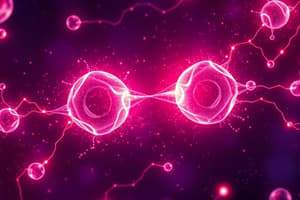Podcast
Questions and Answers
What is the minimum number of valence electrons needed by a carbon atom to form a stable molecule?
What is the minimum number of valence electrons needed by a carbon atom to form a stable molecule?
4
What is the type of bond formed between carbon and hydrogen atoms in a methane (CH4) molecule?
What is the type of bond formed between carbon and hydrogen atoms in a methane (CH4) molecule?
Covalent bond
What is the percentage of ionic character in a bond between two atoms with Pauling electronegativities of 1.3 and 3.5?
What is the percentage of ionic character in a bond between two atoms with Pauling electronegativities of 1.3 and 3.5?
74.2%
What type of bond is formed when electrons are delocalized in a 'sea' of electrons?
What type of bond is formed when electrons are delocalized in a 'sea' of electrons?
What is the primary type of bonding responsible for the strength of a solid?
What is the primary type of bonding responsible for the strength of a solid?
What type of bond is formed when there is a difference in electronegativity between two atoms?
What type of bond is formed when there is a difference in electronegativity between two atoms?
What is the term for the temporary dipoles that form in a molecule due to the uneven distribution of electrons?
What is the term for the temporary dipoles that form in a molecule due to the uneven distribution of electrons?
What is the type of bonding that arises from the interaction between dipoles?
What is the type of bonding that arises from the interaction between dipoles?
What is the electron configuration of a carbon atom in its ground state?
What is the electron configuration of a carbon atom in its ground state?
What is the term for the process of mixing atomic orbitals to form hybrid orbitals?
What is the term for the process of mixing atomic orbitals to form hybrid orbitals?
Study Notes
Ionic Bonding
- NaCl is an example of ionic bonding, where Na (metal) loses an electron to become a stable cation (Na+), and Cl (nonmetal) gains an electron to become a stable anion (Cl-).
- The resulting Coulombic attraction between the oppositely charged ions leads to a stable bond.
Energy and Bonding
- Energy balance is crucial in bonding, with a minimum energy state being the most stable.
- The net energy (EN) is the balance between attractive energy (EA) and repulsive energy (ER).
Examples of Ionic Bonding
- Predominant bonding in ceramics occurs through ionic bonding.
- Examples of ionic bonding include NaCl, MgO, CaF2, and CsCl.
Covalent Bonding
- Covalent bonding occurs when atoms have similar electronegativity, leading to shared electrons.
- Bonding is determined by valence and s & p orbitals.
- Example: H2, where each H atom has 1 valence electron, needs 1 more, and shares 1s electron with the other H atom.
The Periodic Table
- Columns of the periodic table have similar valence structure.
- Electropositive elements (left side) readily give up electrons, while electronegative elements (right side) readily acquire electrons.
Electronegativity
- Electronegativity ranges from 0.9 to 4.1, with large values indicating a tendency to acquire electrons.
- Smaller electronegativity values indicate a tendency to give up electrons.
Ionic Bonding
- Ionic bonding occurs between metal and nonmetal atoms with dissimilar electronegativities.
- Electron transfer is required, with a large difference in electronegativity.
- Example: MgO, where Mg donates electrons and O accepts electrons.
Bond Hybridization
- Carbon can form sp3 hybrid orbitals, allowing it to form four bonds.
- Example: CH4, where C has 4 valence electrons, needs 4 more, and shares electrons with H atoms.
Primary Bonding
- Metallic bonding involves delocalized electrons as an electron cloud.
- Ionic-covalent mixed bonding occurs when both ionic and covalent bonds are present.
Secondary Bonding
- Arises from interaction between dipoles.
- Fluctuating dipoles lead to secondary bonding, such as in liquid H2.
- Secondary bonding occurs between molecules, not within molecules.
Studying That Suits You
Use AI to generate personalized quizzes and flashcards to suit your learning preferences.
Description
This quiz covers the concepts of ionic bonding, including the formation of ions, electrostatic attraction and energy balance. It's ideal for students studying chemistry.




